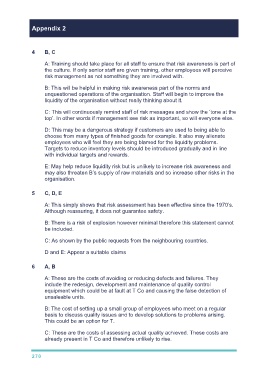Page 280 - Microsoft Word - 00 CIMA F1 Prelims STUDENT 2018.docx
P. 280
Appendix 2
A: Training should take place for all staff to ensure that risk awareness is part of
the culture. If only senior staff are given training, other employees will perceive
risk management as not something they are involved with.
B: This will be helpful in making risk awareness part of the norms and
unquestioned operations of the organisation. Staff will begin to improve the
liquidity of the organisation without really thinking about it.
C: This will continuously remind staff of risk messages and show the ‘tone at the
top’. In other words if management see risk as important, so will everyone else.
D: This may be a dangerous strategy if customers are used to being able to
choose from many types of finished goods for example. It also may alienate
employees who will feel they are being blamed for the liquidity problems.
Targets to reduce inventory levels should be introduced gradually and in line
with individual targets and rewards.
E: May help reduce liquidity risk but is unlikely to increase risk awareness and
may also threaten B’s supply of raw materials and so increase other risks in the
organisation.
5 C, D, E
A: This simply shows that risk assessment has been effective since the 1970’s.
Although reassuring, it does not guarantee safety.
B: There is a risk of explosion however minimal therefore this statement cannot
be included.
C: As shown by the public requests from the neighbouring countries.
D and E: Appear a suitable claims
A: These are the costs of avoiding or reducing defects and failures. They
include the redesign, development and maintenance of quality control
equipment which could be at fault at T Co and causing the false detection of
unsaleable units.
B: The cost of setting up a small group of employees who meet on a regular
basis to discuss quality issues and to develop solutions to problems arising.
This could be an option for T.
C: These are the costs of assessing actual quality achieved. These costs are
already present in T Co and therefore unlikely to rise.
270

